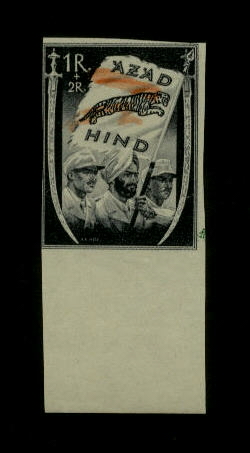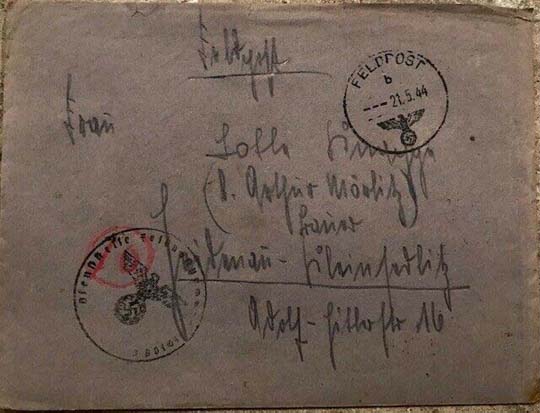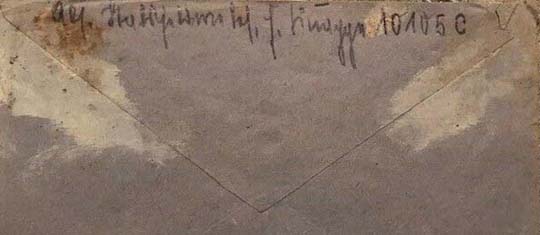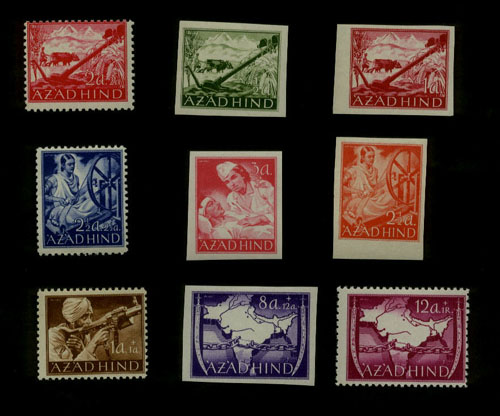Indian
Legion Stamps and Postal History
|
Azad Hind
In 1938, Netaji Subhas Chandra Bose a self-proclaimed nationalist became leader of the
Indian Nationalist Party. The purpose of the Nationalist Party was to expel the British
forces from India by whatever means available.
Bose, who lived in Calcutta was
incarcerated by the British and was later released in 1941 because of his ill health.
During the time of his release Britain and its allies were at war with the Axis powers.
Shortly afterwards on 17 January 1941, Bose who was under British surveillance managed to
escape with the assistance of the "Abwehr," German Intelligence.
He traveled
towards the Northwest part of India, crossing Afghanistan in order to reach the Russian
border, where he was assisted by the "NKVD" Soviet Intelligence. Disappointed that the
Russians would not provided him with support, he fled to Berlin for help.
Arriving in Berlin, he was greeted by top German Foreign Officials. In early 1942, Bose
had signed an agreement with Hitler proclaiming the provisional government of Free India
"Azad Hind."
|

Indische Freiwilligen-Legion 950.
Meanwhile in North Africa, the entire British 3rd Motorized Brigade,
composed of Indian personnel was taken as prisoners of war (POW). On 15 May 1941, a
German intelligence airforce officer was sent to the POW Camp for the purpose of recruiting
English speaking Indian troops. The German officer managed to convince 27 Indian Officers
to fly towards Berlin. These 27 officers and Indian residents living in Germany meet
with the Indian Leader Subhas Chandra Bose where they discussed the propaganda value of recruiting
and forming of the Azad Hind or Indian Legion.
The Indian leader had toured the Annaberg camp, where about 10,000 Indian prisoners were
held; and gathered enough volunteers to form a regiment. Subsequently around 6000 Indian
POWs were recruited and sent to the training camp at Frankenburg. About 300 Indian troops
were selected for further training and sent to Konigsbruck near Dresden, where they received German
uniforms.
A special designated arm shield was worn on their uniform. The shield had the
Indian national colors in horizontal stripes with a leaping tiger superimposed over the white band
of the tricolor and with the inscription "Freies Indien" on top.
Sikhs in the Legion were permitted to wear a turban as dictated by their religion.
These men constituted the "Freies Indien" Legion of the German Army and took their oath of allegiance
in a ceremony on 26th August 1942. Eventually the Indian Legion expanded from 300 to 2000 members.
The Germans designated it the
"Indische Freiwilligen-Legion Regiment 950" (Indian volunteer Legion
Regiment 950), who was commanded by the German officer Oberstleutnant Kurt Krappe.
Its personnel were two-thirds Moslem and one-third Hindu. This time all the Legionnaires wore German
uniforms with an arm shield. The Legion had German Officers and the language used was English.
At Bose's recommendation, all volunteers, regardless of previous rank, began their military training as
privates. By mid-January 1943, the legion effective strength was composed of 1503 Hindus, 516 Sikhs,
497 Moslems and 77 others divided into three battalions. The Indian formation with 2593 men was
attached to the German 404th Infantry Division and assigned to the Zeeland region of Holland.
From early May to early September 1943, the Indian Legion was stationed in Zeeland. On 17 September
1943, the Indian Legion left Haarlem, Holland and re-deployed to St Andre de Cubzac in southwest France.
By early May 1944, the Legion was assigned to the Zandvoort region. In June 1944, the Legion was sent
to the Bay of Biscay, France to relieved the 822nd Georgian Infantry Battalion undertaking "Atlantic Wall"
duties. Following the allied invasion of Normandie, the Legion was withdrawn temporarily to the Netherlands.
By August 1944, the Legion was transferred into the Waffen-SS with a strength of 2300 men. The unit was sent
to France without it's six anti-tank guns and seventy-one motor vehicles. Designated as the
"Indische Freiwilligen-Legion der Waffen-SS"
under the command of SS-Oberfürer Heinz Bertling. However, when Bertling was appointed as new commander he found out via a German message that he was not wanted (even the Indians objected to the change), with this message he returned to Berlin. Command was giving to Kurt Krappe. The Indian Legion was tasked for non-combative assignments and serve for propaganda purposes, however it did confronted French Free troops in
the town of Dun. During house-to-house fighting, the Legion suffered its first combat fatality, Lt Ali Khan,
who was buried with military honors. The legion lost more men killed during night marches through Luzy,
crossing the Loire and moving towards Dijon, France.
By December 1944, the legion was moved into the
empty military training camp at Heuberg, Germany. The Indian troops stayed in Heuberg until the end of
March 1945, when they marched along the Bodensee in an attempt to cross over into neutral Switzerland via
the Alpine passes. It was here where the American and French forces overran the Indian Legion.
They were marched into captivity and eventually shipped backed to India where they awaited their trial for
treason.

Indian Legion Feldpost
Rare feldpost cover mailed on May 5, 1944 by a German cadre
Sergeant Hans Knappe attached to the 7th company of the India Infantry Regiment 950.
The sender was in Bordeaux, Southwest France region.

The reverse shows the senders name, rank and FPN 10105C associated to the Indian Legion..
|
Indian Volunteers in
other Axis formations
The German Branderburgers and agents recruited men from the Indian Legion. The Indian volunteers were
incorporated as part of 4th Regiment, 800.Bau Lehrdivision zür Besonderen Verwendung Branderburg"
(800th Special Purpose Construction Training Division Brandenburg). They were quartered at Meseritz, where
they were trained in parachuting and sabotage operations. In January 1942, 100 Indian airborne troops
were launched into eastern Iran in order to infiltrate into India through Baluchistan and start sabotage
operations against the British. Oberleutnant Witzel in Afghanistan reported to the Abwehr that the Indian
landing had been successful. Eventually the operation was disbanded.
It should be noted that after some success in recruiting Legionnaires, Subhas Chandra Bose was taken by
German submarine U-180, where they were transferred in rough seas near Madagascar to the Japanese submarine
I-29. On 6 May 1943, the Japanese submarine arrived at Sabang harbor on We Island off the northernmost tip
of Japanese occupied Sumatra (Malaysia). There the Japanese took him to Singapore where he set up his provisional
government of Azad Hind on 21 October 1943. He organized an Indian National Army, composed of three divisions
in Burma. These divisions did see some extensive action while fighting along side the Japanese. Some Indian
units under Japanese subordination were allowed to administer the Andaman and Nicobar Islands. Bose was killed
in an air crash on the island of Formosa on 18 August 1945. The Azad Hind movement disappeared with his death.
Meanwhile in early 1942, the Italians formed an Indian Legion in North Africa, by recruiting prisoners of war (POW).
The Indian Legionnaires wore Italian army tropical uniforms. On their right sleeve they wore an arm shield patch showing
the Indian national colors. However the Indian Legionnaires refused to serve under Italian command, and the project was
disbanded.
|
|
Postal History
In February 1943, the German postal service in collaboration
with the Hindu leader Bose printed propaganda stamps
honoring the Azad Hind movement. The designers for the
Indian Legion stamps were two of Germany's top artist, whose
names were Werner and Maria von Axter-Heudtlass. Bose
himself met with Maria von Axter-Heudtlass to approve
certain designs.
Ten stamps were printed with six different
designs. The first seven stamps were semipostals, the surcharge
was for the administration of Andaman and Nicobar Islands under
Japanese control. These stamps were printed in the
"Reichsdruckerei" (Government Printing Office) in Berlin.

Indian Legion Stamps
The stamps show six themes to be depicted on ten denominations.
Three were regulars and the rest semi-postals:
1. Value (1+1
Anna) depicts a Sikh firing a German MG34 machine gun.
2.
Values (1/2, 1 and 2+2 Annas) show a peasant plowing a field.
3. Values (2-1/2, and 2-1/2-2-1/2 Annas), picture a woman
spinning cloth.
4. Value (3+3 Anna), a nurse comforting
a wounded soldier.
5. Values (8+12, 12 Anna +1 Rupee), India
breaking chains.
6. Value (1+2 Rupee), soldiers carrying the
Free India Banner.
A set of 21 stamps exist, which are
perforated (10mm x 12mm) and imperforated. A million copies
were produced for the lower values and 500,000 for higher
values, except the 1+2 Rupee stamp, only 13,500 varieties were
printed. All the stamps exist in different colors and have the
word Azad Hind printed. These stamps were intended to be use by
the Indian forces under Japanese control.
[ Front
Page ] [ Top] [Previous
Page [ Next Page]
|
|
|



